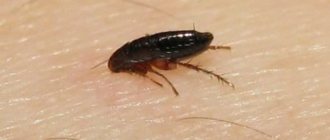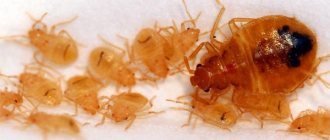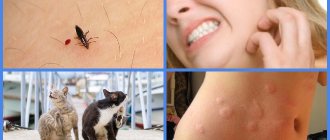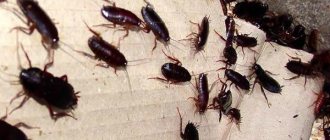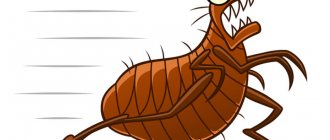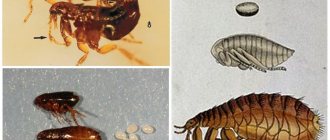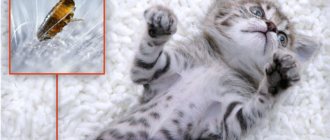For some types of fleas, there is not much difference in who gets a drink of fresh blood. They primarily choose animals as their victims. When they are not nearby, the parasites attack the person. In addition, there is a special type of bloodsuckers that belong to the category of human fleas. They are distinguished by their rather large size up to 4 mm and the ability to feed on the blood of humans and animals.
Are there human fleas?
Fleas are insects that lead a parasitic lifestyle. Bloodsuckers are not very picky about what they eat, especially when they feel hungry.
Do fleas live on humans? Under normal conditions, wingless ones choose the blood of a dog or cat. Small parasites bite humans if they have no other source of food.
However, there is one type of blood-sucking parasite from the Pulex Irritans family that bites humans. The human flea prefers to drink the blood of people, but if they are not nearby, then it can live on the body of almost any mammal.
It is noteworthy that in addition to Pulex Irritans, more than 1,500 species of fleas can consume human blood. But most of them parasitize a certain species of bird or animal.
Most often, humans are bitten by these types of wingless bloodsuckers.:
- Rabbit.
- Feline.
- Rat.
- Canine.
These types of parasites bite humans when there are no hosts nearby. For example, rabbit bloodsuckers often attack hunters.
What other fleas can attack humans?
There are about one and a half thousand species of fleas that are not averse to feasting on human blood.
However, most often a person becomes a victim of the following types of fleas:
1. Felines - they are the most common.
2. Dogs.
3. Rat - during the Middle Ages they were active carriers of the plague.
4. Rabbit fleas - most often this type of flea is found in the wild and attacks humans during a hunt.
At the same time, hunters often say that they were bitten by earthen fleas, however, such fleas do not exist. They are confused with herbivorous beetles, which only harm vegetable gardens and fields. In fact, hunters are bitten by fleas that jump on them from fox or rabbit holes.
The most painful bites for humans are flea bites from herbivorous animals. According to eyewitness accounts, a moose flea bite is much more painful than a bee sting.
Appearance of a flea
If pinpoint bites appear on the human body, and small insects are jumping around the house, in order to determine their species, you need to understand what human fleas look like. Human parasites are very similar to other types of blood-sucking, wingless insects.
The pests are very small, they have a flattened body . Parasites have a small head and no wings. The size of an adult insect is about 3 mm.
A bloodsucker that bites a person has 6 legs, and its hind legs are more developed. This gives him the ability to jump over a long distance (1.5 m).
An insect that prefers to suck human blood has a developed oral apparatus. This allows him to inject and easily draw the red liquid from the vessels.
How to tell if there are fleas
The presence of a blood-sucking parasite can be determined by examining its bites. Some people think that fleas live on a person's head. But in reality, human insects feel absolutely comfortable when they land on the face, arms, neck, back, legs or stomach.
The bites of wingless parasites are very painful, so they are well felt.
Symptoms of fleas in humans:
- the presence of red spots at the site of the bite.
- Purple spots become swollen and itchy.
- When scratching, wounds and abrasions appear.
- If infection penetrates into the affected areas, ulcers form.
When a human flea bites the scalp, unlike lice, its bite is painful. At the same time, the parasite that selects human blood is more mobile and jumps well.
Effective means
If you are thinking about how to remove fleas from a person, then keep in mind that the solution to the problem must be comprehensive. It includes several stages.
This is how premises are treated for fleas
- Treatment of premises in order to destroy adult insects, their larvae and eggs. It is carried out using insecticidal agents such as organophosphorus substances (for example, dichlorvos) or pyrethroids (permethrin and its derivatives). If you want to get rid of fleas in your own home, it will be useful to treat not only the house, but also the area. Grass is an excellent breeding ground for fleas. If you are fighting in an apartment on the ground floor, then you should start by treating the basement.
- Processing animals to kill insects. It is carried out with drugs similar to those used in the first case. They are available in the form of sprays, insectoacaricidal powder, shampoos or concentrates, which must be diluted with water and applied to animal fur. This stage is required if your pets are severely infected. Only after all the parasites have been destroyed does it make sense to use collars and drops on the withers.
- Prevention of fleas on pets. The most effective are drops (their range is very extensive - from inexpensive “Dana” to complex preparations (Advantix, Inspector, Lawyer). One of the drugs with a good price-quality ratio is Bars and Bars-Forte. Among the collars, the most effective are Kiltix, Golden Defense. Reasonably priced - Bars and Fiprist. It is important to remember that these drugs begin to act only after the active substances penetrate the sebaceous glands of animals. Therefore, they are put on and applied no earlier than 3 days after bathing and no later than 3 days before him.
- Prevention of flea bites and their entry into the house from a walk. Carried out with repellent agents such as OFF, Gardex. Before using them, it is better to find out from the instructions exactly how they are applied. Some clothing sprays cause irritation when they come into contact with human skin.
In conclusion, I would like to note that people knew about the dangers of fleas for humans already in ancient centuries. To collect annoying insects, hare skins were used to collect fleas. Periodically they were burned and replaced with new ones. Since then, repellent plants have been known - pyrethrum (chamomile, which has a characteristic odor, from which the first pyrethroids were obtained), wormwood and others were widely used to add hay to mattresses and in the manufacture of bedding.
Modern means allow you to rid your home and pets of insects in a short time. It is only important to understand how to use them correctly so as not to harm the health of your household.
How to get rid of insects
There are many ways to remove fleas from humans. So, if there are animals in the house, then it is necessary to treat the pets’ fur with a special shampoo or products. For prevention, you should put a special collar on your cat or dog.
It is recommended to do a thorough cleaning of the entire house. It is recommended to thoroughly clean carpets, furniture and bedding where animals lie.
Exposure to temperatures will help get rid of wingless ones. You can wash things in the hottest water possible or ventilate the room on a sunny day.
Freezing will also help eliminate human parasites. Therefore, in winter it is necessary to ventilate the apartment as often as possible. But this method is not suitable for a person prone to colds.
Effective methods for removing pests that suck human blood are the use of chemicals or folk remedies. If the effectiveness of such measures is low, they resort to the services of professional exterminators.
Chemicals
Since fleas feed only on blood, there is a small list of means to eliminate them. For example, this type of parasite does not eat bait.
To combat fleas in humans, 2 types of products are used:
| Type of chemical | Action | Name |
| Aerosols | They enter the body of bloodsuckers along with the air. They have a quick effect and do not destroy larvae or eggs. | Gardex, OFF-Extreme, Gall-Rat, Bee Ban |
| Suspensions and powders | Active components penetrate the skin of pests. These products are considered more effective than sprays and have a long-lasting effect. | Cypermethrin, Get, Tetramethrin-pyrethroid |
How to get rid of fleas on the human body and how to repel fleas from a person? Since Pulex irritans is not constantly present on its host, there is no need to use potent agents to destroy them.
But to repel pests, you can treat the skin with preparations whose smell repels human insects (clove extract, lemon extract, wild garlic solution).
Folk remedies
If a person has fleas, it is important to know how to protect yourself from them using folk remedies. There are many ways to get wingless pests out of your home.
The most effective and popular means are soda, salt, pine shavings, yeast, garlic and herbs. Moreover, any of these components is absolutely safe for humans.
Soda and salt are combined in equal quantities. The mixture is scattered in corners and other places where parasites live. After a day, you should vacuum everything thoroughly.
Coniferous needles and wormwood have a pronounced antiparasitic effect. Dry plants are scattered in front of the entrance to the house and placed in any cracks. This will prevent pests from entering the home and getting on the human body.
Chopped garlic is mixed with brewer's yeast. The composition is applied to the floor and baseboards. After 10 hours, the treated areas are vacuumed and washed.
Herbal infusions are considered effective remedies against wingless insects . Most of all, human fleas (and not only) are repelled by the smell of eucalyptus, lavender, tansy and wormwood. All plants are mixed in equal quantities, poured with water, and boiled. The resulting solution is used to wash floors and wipe surfaces where bloodsuckers live.
Professional pest control
Specialized protection against fleas is necessary if the number of human parasites is very large and it is not possible to get rid of them on your own. Employees of the sanitary and epidemiological station and private offices that carry out pest control can professionally treat your home.
The liquidation procedure takes 20 or 60 minutes. Services use 2 effective treatment methods - cold and hot fog.
The chemicals disperse into small droplets that float in the air for another 4-7 hours. The procedure allows you to eliminate adult fleas and their eggs.
Flea remedies for children
Fleas do not live permanently on the human body. Pests move to the skin to feed, and then return to their habitats (bedding, baseboards, cracks).
In view of this, there is no need to treat the body with special means. But if there are too many human insects and they constantly bite, using a special anti-flea shampoo will help protect the delicate baby scalp.
The child's body can be treated with safe products that will repel blood-sucking parasites. To relieve unpleasant symptoms, hydrogen peroxide and brilliant green are applied to the bite sites. Fenistil is used for itching.
Fighting methods
If you've ever encountered them, then you know for sure whether cat fleas bite people. Cats, dogs, pet rabbits or ferrets can cause these parasites to appear in every home. Given the fact that the flea's life cycle takes place outside of its victims, it is understandable that flea shampoo for humans is not an effective treatment.
Insecticidal preparations
Special insecticidal preparations are used to kill fleas. Their use requires time (exposure) and the correct choice of doses. If possible, it is better to entrust the fight against fleas in your home to specialized organizations. Anti-flea medications are available in the form of concentrated substances that require dilution or in the form of sprays. Sprays are convenient, but quite expensive, so concentrates are more often used to treat the room.
When choosing how to remove fleas from your home, try to ensure that the preparations used do not contain the same active ingredient. Apart from overdose and possible intoxication, this will not give any results.
Advice. “It is important to understand the purpose of the drugs you choose and not hope that you can kill fleas using products with a repellent effect. All flea products for people are repellent. They prevent fleas from staying on the skin and starting to bite, but they don't kill them."
How to distinguish a human flea from an animal one
The appearance of human fleas is similar to that of other types of wingless insects. The main difference between Pulex Irritans is the presence of a flattened body on the sides. Thanks to this shape, human parasites easily move around the body and do not get tangled in the hair.
But experts are convinced that fleas that parasitize humans are almost impossible to distinguish with the naked eye. Therefore, only an entomologist can distinguish insects using a microscope or a photo where the parasite is increased in size.
Externally, human fleas are small brown grains that move. People often confuse fly larvae with the larvae of wingless insects, since they are almost identical in appearance.
Special signs of human fleas:
- the body is black-brown in color.
- Flattened body.
- Lack of wings.
- The body and paws are covered with hairs and hooks.
Flea: photo
Fleas differ from most domestic insects in that they are extremely small in size and move mainly by jumping.
- Adult human fleas range in size from 0.5 to 5 millimeters.
- Color can vary from copper-brown to almost black.
- The insect has two pairs of legs, the back ones are much longer than the front ones, as they are designed for jumping.
- Flea eggs are off-white in color, up to 0.5 millimeters long.
- The larvae, up to 5 millimeters long, have a round body, divided into segments and covered with hairs.
A large, detailed flea in a photo is always a greatly enlarged image made using special instruments and optics. In fact, fleas look like small black dots that, due to their jumping ability, can dematerialize as soon as you notice them.
Human flea development cycle
The life cycle of the human flea is similar to other species of wingless insects. The only differences are the laying of a huge number of eggs by the female (2000 in her entire life) and the parameters of adults.
Bloodsuckers go through 4 stages of development:
- eggs;
- larvae;
- cocoons;
- sexually mature individuals.
Having had enough, the female lays eggs in various places - bedspreads, wool, clothes, sofas, carpets, etc. Eggs mature in about two days.
After hatching, the larvae begin to actively absorb the excrement of adult insects and other waste. Pulex irritans go through several stages of development, and then they pupate.
To emerge from the cocoon, the parasite needs a favorable environment. Therefore, the time from the moment the egg develops to the hatching of a new individual can last from 15 days to a year.
Protective agents against fleas in humans
It is necessary to get rid of ectoparasites with the help of insecticides, and for protection you need to use repellents. These are pest control agents that repel insects from humans. The most popular repellents contain the following chemical compounds:
- diethyltoluamide;
- dimethyl phthalate (DMF);
- akrepom.
Deterrents are produced in the form of aerosols, lotions, creams, pencils, emulsions, and wet wipes. Essential oils of fir, juniper, pine, spruce, and lemon balm are used as natural repellents.
What is the danger to humans?
At first glance, human fleas appear to be relatively harmless. After all, they are microscopic in size, and small red dots remain at the site of their bite.
However, in the area where human insects have drunk blood, pulicosis often occurs.
This condition manifests itself with symptoms similar to allergies.:
- headache;
- rash;
- increased size of lymph nodes;
- suppuration;
- nervousness;
- formation of ulcers in the throat and mouth;
- sleep disorder;
- temperature increase.
Severe pain occurs at the sites of flea bites. The bloodsucker injects an enzyme into the wound that prevents blood clotting.
More serious consequences of flea parasitism on humans include allergic reactions of varying severity, hepatitis C and B, salmonellosis, brucellosis, tularemia, and encephalitis. Few people know that flea bites lead to the development of the Siberian plague, from which every 10 people died in past centuries.
How dangerous are fleas to humans?
Human fleas not only cause unpleasant bites, but are also carriers of many dangerous bacterial and parasitic diseases.
It was fleas that caused epidemics of plague and typhoid. Also, through the bite of an ordinary human flea, you can become infected with encephalitis, tularemia, listeriosis and pseudotuberculosis.
Flea bites are dangerous for allergy sufferers, small children and asthmatics: the body's reaction can be unpredictable.
Fortunately, modern medicine has an extensive arsenal of tools to combat both human flea bites and subsequent complications.
Answers to popular questions
There are a number of questions regarding human fleas that most people want to know the answers to. So, many people are interested in whether fleas can live in human hair. As mentioned above, wingless insects do not permanently live on mammals. But in order to get enough, parasites can climb onto all parts of the human body, including the head.
Where do fleas live? Bloodsuckers prefer to live near a food source, but in secluded corners.
Favorite places for parasites to live:
- carpets;
- pet bedding;
- basement;
- genital slits;
- pantry;
- bedspreads;
- cloth;
- baseboards;
- attic
- cushioned furniture.
In all these places, insects not only live, but also reproduce.
How long do fleas that drink human blood live? The average life cycle of the parasite is 2-3 months. Given comfortable conditions, the insect can survive up to 1.5 years.
Why don't fleas live on people? There are a number of factors that do not allow bloodsuckers to live on the human body. The first reason is that the body temperature of humans is lower than that of dogs or cats. The second factor is that a person maintains hygiene, the third is that people do not have thick fur where insects could hide.
Where do human fleas come from?
To get enough food, hungry insects can settle in the fur of dogs, rodents, birds or cats. Therefore, pets often bring parasites into their owners' homes.
Fleas can also appear on people after walking outside, where pests could easily jump onto clothes and shoes. Often, human parasites enter apartments from staircases or from neighbors . 90% of insects live in the basement, from where they easily enter the living space through walls and cracks.
It is noteworthy that the flea that bites humans is a modified species of insect. Pulex Irritans is a consequence of mutation and environmental characteristics. But despite the specific nature of the formation of this type, it can be destroyed using methods used to eliminate other parasites.
Do fleas feed on human blood?
All adult fleas feed exclusively on blood. Therefore, they choose any warm-blooded creature for themselves. If the food source moves or dies, the insect begins to starve.
When there is no animal near the parasites, they drink human blood . Therefore, when pests appear in the house, the first step is to remove them from your pets.
It is noteworthy that human fleas, in the absence of people, can also feed on the blood of birds and animals.
